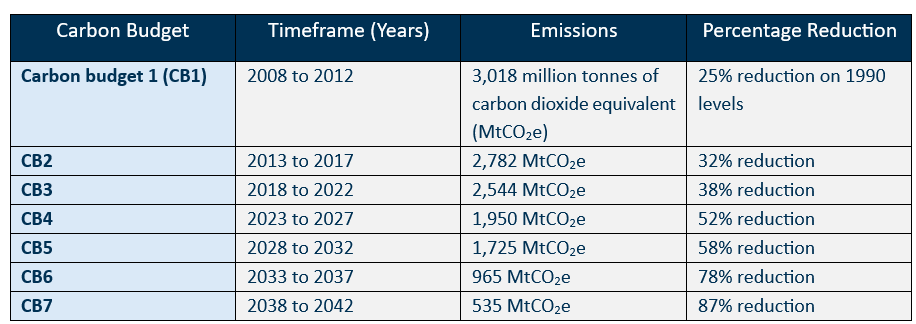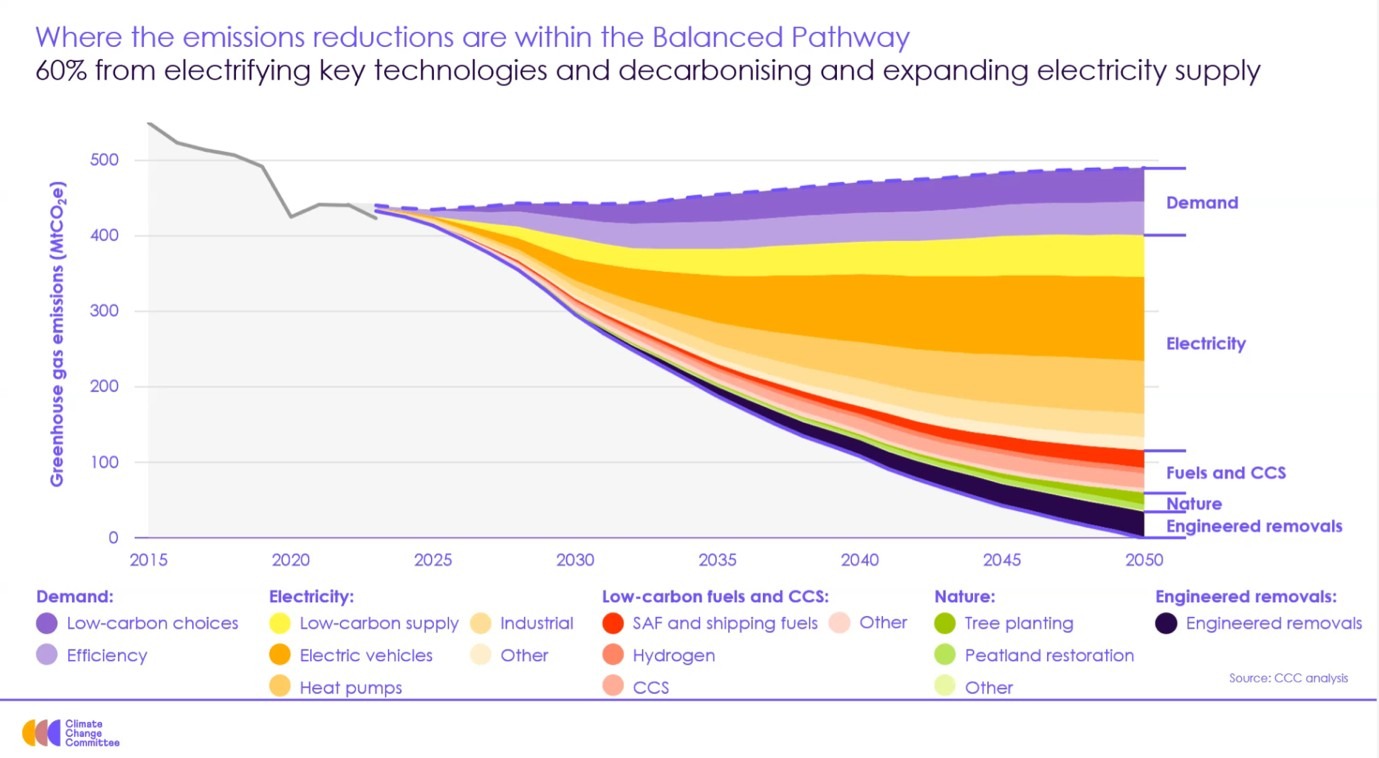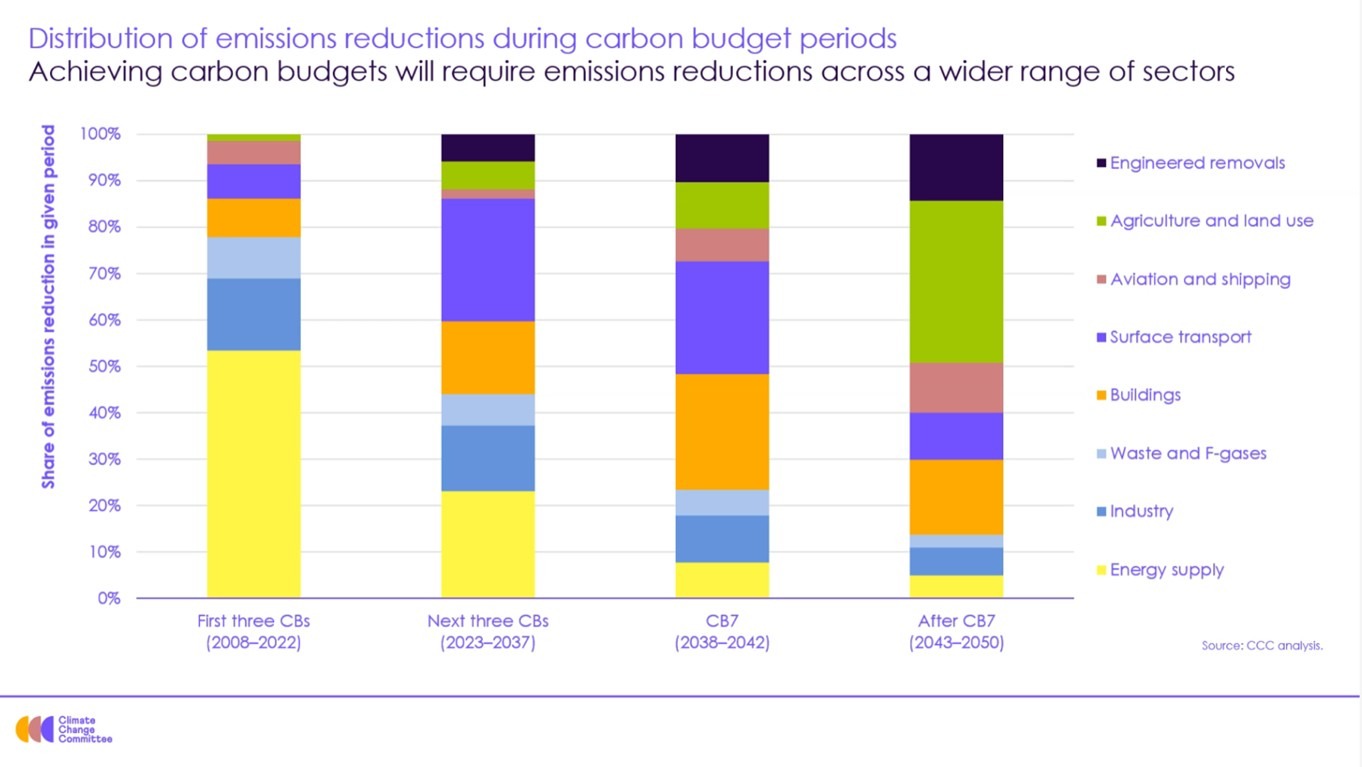
The UK's NDC and the Seventh Carbon Budget
Introduction
As outlined in our latest UK Policy Briefing, the start of 2025 has seen a range of climate policy announcements. This briefing offers a closer look at two of the major policy developments that have emerged in recent months that boards should be aware of: the UK’s updated 2035 Nationally Determined Contribution (NDC) and the Climate Change Committee (CCC)’s Seventh Carbon Budget: Advice to the UK Government (CB7). Developments in these policy areas have a range of business impacts and it is important that boards are up-to-date on the latest Government thinking on emissions reductions and strategic delivery of climate action in the UK.
Board discussion areas
- Do our ambition levels align with the Government’s 2035 NDC plan? What specific areas of our operations present challenges in terms of raising ambition?
- How does alignment with the UK’s NDC and Carbon Budget fit into our case for investment? How can we better strategically align ourselves to the direction of travel for climate policy?
- From a business perspective, what is needed to help close the ambition-action gap in climate policymaking? What forms of Government support are needed to better enable businesses to deliver on the objectives of the updated NDC and Seventh Carbon Budget? Where is more guidance needed?
- Can we identify and incorporate any emerging risks related to climate policy shifts that could impact our reporting obligations?
- How might the updated NDC influence the speed and cost of our transition to low-carbon operations, and are we financially prepared for these changes? Are there new opportunities for investment, funding, or industry collaboration arising from the UK’s enhanced climate commitments that we should explore?
What to know about the UK NDC
Nationally Determined Contributions (NDCs) are one of the primary instruments for achieving the Paris Agreement – a legally binding international treaty adopted in 2015 by all 196 Parties to the United Nations Framework Convention on Climate Change (UNFCCC). As members of the treaty, all 196 parties are required to develop these national climate pledges identifying how they will contribute to reducing greenhouse gas (GHG) emissions and achieving net zero by 2050 and limiting global warming to 1.5°C. With an emphasis on short- to medium-term goals, NDCs are required to be updated every five years, and each update is required to raise the ambition level of the respective country’s climate action. This is referred to as the “ratchet mechanism” of the Paris Agreement, in which ambition steadily increases over time to ensure that decarbonisation is reached in the second half of the century and that global temperatures are kept “well below 2°C”. February 2025 marked the latest deadline for all Parties to submit their third round of NDC climate pledges (also referred to as NDCs 3.0), which are required to cover the period 2031–2035.
Published on 30 January 2025, the UK’s 2035 Updated Nationally Determined Contribution confirms the topline ambition of reducing emissions by 81% (based on 1990 levels). This target is in line with advice given by the Climate Change Committee in October 2024, and represents a 1.5°C-aligned, economy-wide absolute emissions reduction target, covering sectoral greenhouse gas emissions broken down into energy (including transport); industrial processes and product use (IPPU); agriculture; land-use, land-use change and forestry (LULUCF); and waste.
The NDC also clarifies the UK’s commitment to specific outcomes of the UNFCCC Global Stocktake (GST) undertaken at COP28 in Dubai in 2023 including the global goal of tripling renewable energy capacity and doubling the average annual rate of energy efficiency improvements, as well as accelerating efforts towards net zero emission energy systems through the utilisation of low-carbon fuels well before or by 2050.
A number of the UK Government’s ongoing climate policy commitments are affirmed in the 2035 NDC including:
- The Warm Homes Plan’s initial £3.4 billion in funding towards heat decarbonisation and household energy efficiency and the Warm Homes: Social Housing Fund and the Warm Homes: Local Grant
- The Clean Power 2030 Action Plan to reduce the carbon intensity of the UK’s energy generation to well below 50gCO2e/kWh in 2030
- Reducing road transport emissions through the Zero Emission Vehicle (ZEV) mandate and the phase-out of new internal combustion cars by 2030, and ongoing consultation on the sale of hybrid vehicles from 2030 to 2035
- Delivering on the Global Methane Pledge to collectively reduce global methane emissions by at least 30% by 2030 (compared to 2020 levels)
- Continuing the work of the Powering Past Coal Alliance and encouraging other countries to follow the UK’s lead in coal power phase-out
- The 30x30 commitment to protect 30% of UK land and sea by 2030, supporting the nature-based solutions needed to achieve net zero and deliver the commitments of the Environment Act 2021.
Responses to the NDC update have applauded the ambitious new goal of an 81% reduction in emissions, but there is concern that the plan “has not explained how it will achieve the goal,” especially as it does not set targets for sectors like farming, aviation, or energy. Nevertheless, there is clear acknowledgement of the essential role local government plays in driving action to help realise national net zero targets, and the forms of Government support available, as seen with the forthcoming Great British Energy Local Power Plan, English Devolution White Paper, and the endorsement of the Coalition for High Ambition Multilevel Partnerships for Climate Action pledge. The NDC sets out the necessity for bringing together public and private sector investors and their local communities to make the journey to net zero both fast and fair. In its information to facilitate clarity, transparency and understanding (ICTU) of the 2035 NDC submitted to the UNFCCC, the UK Government aims to clarify businesses’ role in leading the way in the net zero transition, asserting:
“With more than 90% of global GDP now covered by net zero targets and a growing demand for low-carbon products and services, businesses are uniquely positioned to lead this transformation. […] Businesses also play an important role in advocating for ambitious policy frameworks, driving sustainable finance, and committing to transparent emissions reporting and science-based targets. By aligning ambition with action, businesses and policymakers can jointly ensure the effective delivery of the UK’s 2035 NDC.”
The opportunity for UK businesses looking to ratchet up their own science-based climate ambition and transition planning practices is reinforced by analysis from Carbon Brief which finds that 95% of countries missed the February NDC submission deadline, furthering the UK’s position as an early leader in setting out a “credible contribution to limiting global warming to 1.5°C above pre-industrial levels.” The Institutional Investors Group on Climate Change (IIGCC) highlights that this represents an opportunity for the UK to be a true leader in national ambition across the public and private sector, which may have a ripple effect on other countries, helping to build confidence and momentum in robust and ambitious climate commitments. The updated NDC is a significant indication from the UK Government of its support of local governance, business leadership, and the nature and biodiversity priority in net zero delivery.
What to know about the UK’s Seventh Carbon Budget
|
NOTE: In terms of measuring alignment between the UK’s NDC and Carbon Budget, the reporting period of the January 2025 updated NDC (2031–2035) aligns with the timeframe of the Sixth Carbon Budget (2033–2037) – despite the release of the Seventh Carbon Budget in early 2025. Thus, assessment of the updated NDC’s emissions reductions alignment is measured against the Sixth Carbon Budget (CB6). For reference, the updated NDC’s commitment to reduce emissions by 81% by 2035 builds on the target set for CB6, which commits to a 78% reduction by 2037. |
The Climate Change Committee (CCC) released its statutory report Seventh Carbon Budget: Advice to the UK Government on 26 February 2025. The UK’s Carbon Budgets set a legally binding cap on the maximum level of emissions (‘the net UK carbon amount’) for a period of five years, as per pre-established secondary legislation under the Climate Change Act 2008 (Section 34). The Seventh Carbon Budget (CB7) will set the UK’s legal limit for greenhouse gas emissions for 2038 to 2042, with the CCC advising that the UK will need to deliver an 87% reduction in emissions by 2040 (against a 1990 baseline) if it is to meet its 2050 net zero commitment. By this target, the CCC advises that UK greenhouse gas emissions over the five-year period 2038 to 2042 should be limited to 535 MtCO2e, inclusive of international aviation and shipping emissions. It is suggested that this be met through domestic action without resorting to international credits (also referred to as ‘carbon units’).
While the CCC’s advice is not legally binding, the Government has traditionally followed it. As an independent statutory body established under the Climate Change Act 2008, the CCC is responsible for assessing the UK’s progress against the carbon budget targets. This is largely achieved through the publishing of annual progress reports to Parliament, with the next Progress Report scheduled for June 2025.
So far, six carbon budgets have been set into law covering the period of 2008 to 2037. CB7 follows the Sixth Carbon Budget (CB6) which was set in 2021 and was the first carbon budget to include emissions targets for the international aviation and international shipping sectors. Importantly, in their advice, the CCC highlights that the Government has yet to reflect this shift towards accounting for international aviation and shipping emissions in legislation, and calls for it do so when setting CB7. Recent announcements around the Government’s support of expansion of a third runway at Heathrow Airport and subsequent feedback from some commentators that airport expansion “remains incompatible with meeting our climate targets” has highlighted the need for clarity around accounting for such emissions. Similarly, questions have been raised around how the Government’s pro-growth agenda and focus on building infrastructure – including 1.5 million homes – is to be effectively delivered in a way that is consistent with decarbonisation requirements.

*The information in this table is sourced from the House of Commons Library.
The CCC presents its sector modelling and data analysis in its ‘Balanced Pathway’ for emissions reductions, which has been developed to provide the basis for the recommended level of emissions reductions in line with the UK reaching net zero by 2050. The pathway’s modelling suggests that around three-quarters of the emissions reductions are expected to take place in the 15 years from now until 2040. According to this, the CCC estimates that the net costs of net zero will be around 0.2% of UK GDP per year on average. Upfront investment – much of which is expected to come from the private sector (i.e. businesses are expected to fund 65-90% of the transition between 2025 and 2050) – is projected to lead to net savings during the Seventh Carbon Budget period, with £35 billion expected by 2050. In total, the CCC projects that the transition would have a net cost of around £108 billion out to 2050, which is 73% lower than previous projections offered in the CCC’s CB6 advice.
The identified technologies for delivery include: electricity, low-carbon fuels and carbon capture and storage (CCS), nature, engineered removals, and demand. Across the CCC’s advice, electrification is expected to be the primary driver of emissions reductions in both homes and the industrial sector, with 60% of the emissions reductions in the Balanced Pathway coming from electrifying key technologies and decarbonising the electricity supply. Generally, the focus is on “scaling up existing solutions rather than banking on future technological breakthroughs,” with strong emphasis on heat pumps, electric vehicles, improved insulation, and the rapid expansion of wind and solar energy. The CCC recommends that 80% of cars on the road by 2040 should be fully electric – which would require nearly all new car sales to be electric from 2030 – and that more than half of homes should be heated by heat pumps by 2040, up from around 1% now. This is reflected in significantly increased focus on home-grown energy production, with total net energy imports expected to fall from 867TWh in 2025 to 202TWh in 2050.

CCC's Balanced Pathway infographic. Source: Climate Change Committee.
43 priority actions are identified to put the UK on track to deliver CB7. These actions are underpinned by seven themes:
- Electricity needs to be cheaper, in order to incentivise a switch to low carbon technologies across sectors.
- Planning, consenting, and regulatory funding barriers must be removed, to enable grid connections and rapid deployment of low carbon technologies.
- Government must provide certainty by committing to timely decisions on new technology choices.
- Households, especially low-income households, must be supported to install low-carbon heating to help address barriers presented by upfront costs.
- Businesses need clarity on the balance between government support and market mechanisms.
- Growing workforces will be a critical enabler, thus a plan for supporting workers is required.
- An engagement strategy for households and businesses is needed, to better communicate the choices available to them.
Priority actions and emissions reductions projections are split by sector, In the case that emissions reductions in surface transport and residential buildings are achieved, the ‘After CB7’ period will see engineered removals, aviation, and agriculture as the dominant sources of UK emissions (see CCC'S distribution of emissions reductions below). Nature-based carbon sequestration measures are identified as a critical component to offsetting residual emissions from the agriculture and land use sectors, with the scale-up of peatland restoration from 26% in 2023 to 55% in 2040 set to deliver over half the land use emissions reductions in the Balanced Pathway. The CCC has also recommended it is critical that tree planting rates more than double per year by 2030 to enable the required levels of woodland restoration and land-based emissions reductions. There are a number of cross-cutting priorities identified including, strengthening the UK Emissions Trading Scheme (UK ETS), publishing a net zero skills action plan, and removing levies and other policy costs from electricity bills. The CCC also recommends that the Government develop a contingency framework to establish indicators for potential emissions reductions shortfalls. A more in-depth consideration of a number of CB7 policy-specific areas is provided in a briefing from the Energy & Climate Intelligence Unit.
 CCC'S distribution of emissions reductions. Source: Climate Change Committee.
CCC'S distribution of emissions reductions. Source: Climate Change Committee.
Reactions to CB7 proposals have welcomed the CCC’s recognition that local leadership is crucial to delivering net zero, with local authorities being uniquely positioned to deliver the practical solutions that work for communities. Some commentators have stated that there remain a number of gaps in thinking on nature and resilience, particularly in terms of how these priorities are funded and delivered. The Wildlife Trusts have suggested that the “nature lever in net zero could be pulled harder”, commenting that the CCC’s advice is currently only making “passing references to adaptation”. Concerns have also been raised that the CCC’s plan places “enormous responsibility on some key technologies and their rapid roll[out]”, and that it will be important to also fully consider the ‘social’ transformation needed to unlock the benefits of net zero. In line with this, there have been strong calls on the private sector to not only lead on the rollout of low-carbon technologies, but also in “the building of consensus for social change” towards climate mainstreaming.
In terms of next steps, building on the CCC’s advice, the UK Government is now required to propose an official level for the Seventh Carbon Budget to Parliament, which must be approved or rejected by 30 June 2026. This aligns with the upcoming spending review, which the Confederation of British Industry (CBI) suggests will be key for “setting out these next steps and building the policy frameworks that businesses require to support the delivery of the carbon budgets.”


